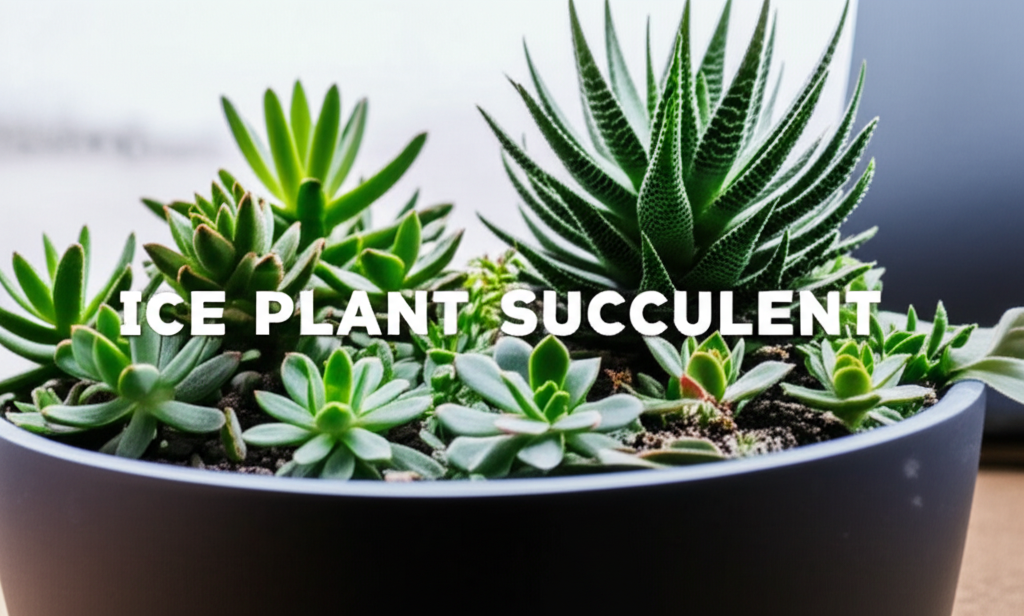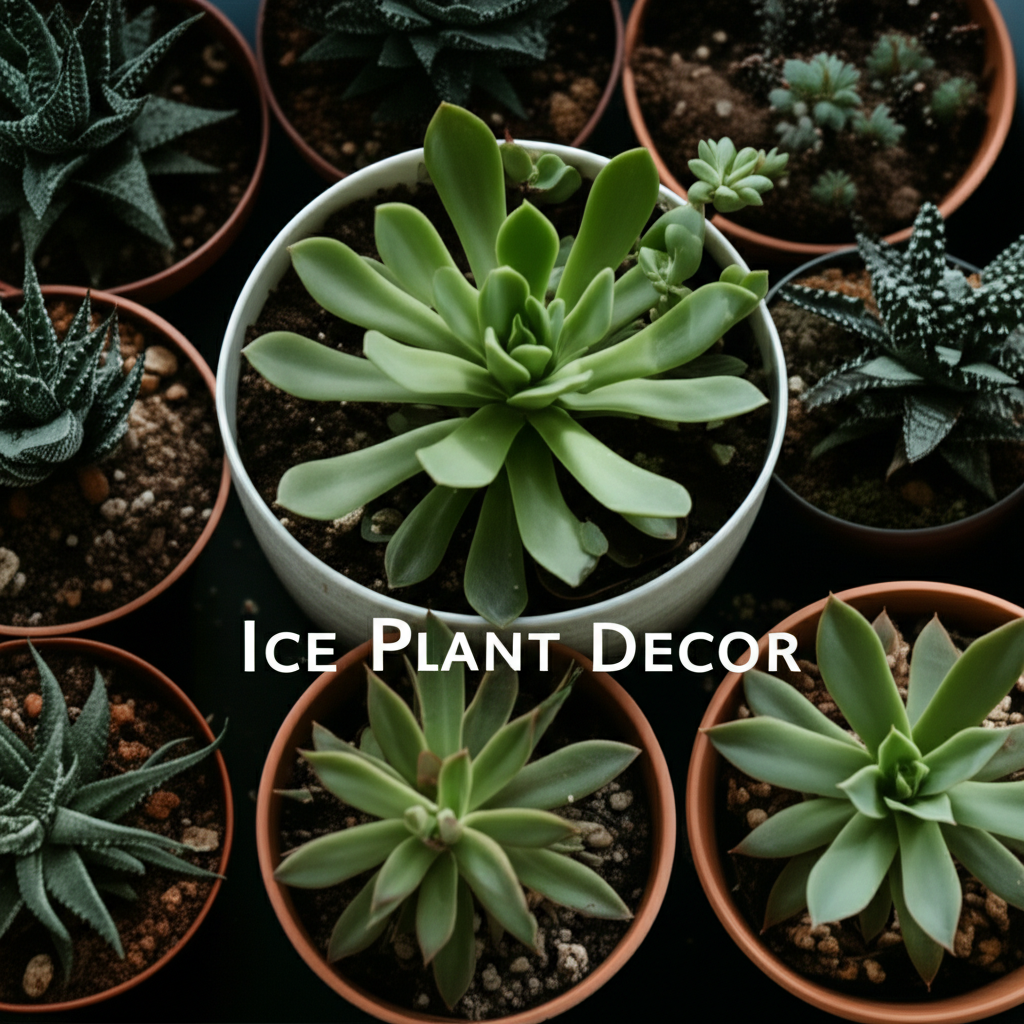Introduction: The Allure of the Ice Plant for Indoor Decor
Ice plants, belonging to the Aizoaceae family, are a captivating group of succulents renowned for their unique, crystal-like epidermal cells (papillae) that shimmer and reflect light, giving them their common name. These fascinating plants offer a low-maintenance yet visually striking addition to any indoor decorative garden. Their diverse forms, from trailing varieties to compact rosettes, provide endless possibilities for creative arrangement. This guide will delve into crafting a mesmerizing indoor ice plant succulent garden, covering everything from selecting the right species to designing an aesthetically pleasing and thriving layout.
Understanding Ice Plants: Key Characteristics for Indoor Cultivation

Before diving into design, it’s crucial to understand the fundamental needs and characteristics of ice plants that influence their placement and care within an indoor environment.
Light Requirements: The Sun-Kissed Illusion
Ice plants, like most succulents, thrive in bright light. For indoor cultivation, this translates to:
- A south-facing window is generally ideal, providing several hours of direct sunlight daily.
- East or west-facing windows can also work, but may require supplemental lighting, especially during winter months.
- Signs of insufficient light include etiolation (stretching and becoming leggy) and a loss of the characteristic vibrant coloration.
- Too much intense, direct midday sun, particularly through glass in very hot climates, can sometimes scorch the delicate papillae, though mature plants are generally quite resilient.
Watering Needs: The Art of Thirst Management
Overwatering is the most common pitfall for succulent care. Ice plants prefer to dry out thoroughly between waterings.
- Water deeply when the soil is completely dry to the touch, typically every 2-4 weeks depending on the season, humidity, and pot size.
- During winter dormancy, reduce watering significantly, perhaps only once a month or even less.
- Ensure excellent drainage to prevent root rot.
Soil and Drainage: The Foundation of Health
A well-draining potting mix is paramount.
- A cactus or succulent mix is a good starting point.
- You can create your own by mixing equal parts potting soil, perlite, and coarse sand or pumice.
- Pots with drainage holes are non-negotiable. Terracotta pots are an excellent choice as they allow the soil to breathe and dry out faster.
Temperature and Humidity: Mimicking Natural Habitats
Ice plants are generally forgiving with indoor temperatures.
- They prefer average room temperatures, between 65-75°F (18-24°C) during the day.
- Nighttime temperatures can drop slightly, but avoid prolonged exposure to temperatures below 50°F (10°C).
- While they tolerate average indoor humidity, excessive humidity can be detrimental. Good air circulation is key.
Selecting Your Ice Plant Stars: A Variety of Forms and Features
The diversity within the Aizoaceae family offers a rich palette for your indoor garden design. Consider these popular and adaptable varieties:
Delosperma (Ice Plant): The Trailing Beauties
These are perhaps the most recognizable ice plants, often grown for their prolific, daisy-like flowers and trailing or creeping habit.
- Delosperma cooperi: Known for its vibrant magenta flowers and spreading growth.
- Delosperma echinatum: Features fuzzy, knobby leaves that give it a unique texture.
- Delosperma lineare: Has fine, needle-like leaves and bright yellow flowers.
Lithops (Living Stones): The Masters of Camouflage
These intriguing succulents perfectly mimic pebbles or stones, offering a minimalist and abstract aesthetic.
- They have very thick, fused leaves that store water.
- They flower profusely, often in shades of white, yellow, or pink, emerging from the split between the leaves.
- Proper watering is critical; overwatering can be fatal.
Conophytum: The Tiny Marvels
These small, often clustered succulents form mesmerizing patterns with their rounded, fused leaves.
- They come in an incredible array of colors and textures.
- Many varieties have a distinct resting period where they shrink and wrinkle.
- Their small size makes them ideal for miniature arrangements and fairy gardens.
Pleiospilos (Split Rock Succulent): The Stone Mimics
Similar to Lithops, these succulents also resemble small stones or rocks.
- They typically have two pairs of leaves that are thick and segmented.
- They are known for their large, bright yellow flowers that can emerge from the central split.
Key Facts and Comparison of Popular Ice Plant Varieties
To aid in your selection, here’s a comparative overview of some popular ice plant genera suitable for indoor gardening:
| Characteristic | Delosperma | Lithops | Conophytum | Pleiospilos |
|---|---|---|---|---|
| Growth Habit | Trailing/Creeping | Compact, fused leaves | Clustered, small bodies | Clump-forming, stone-like |
| Leaf Appearance | Fleshy, sometimes fuzzy | Thick, paired, often patterned | Small, rounded, diverse textures | Thick, segmented, stone-like |
| Flowering | Prolific, daisy-like | Large, central | Small, often in clusters | Large, central |
| Watering Sensitivity | Moderate | High (prone to rot) | Moderate to High | Moderate (prone to splitting) |
| Light Needs | High | High | High | High |
| Ideal for Arrangement Style | Hanging baskets, cascading edges | Minimalist, rock gardens | Miniature arrangements, terrariums | Single specimen, focal points |
Designing Your Indoor Ice Plant Garden Layout: From Concept to Creation
The layout of your indoor ice plant garden is where creativity flourishes. Consider the interplay of textures, colors, and forms to create a harmonious and visually appealing display.
Container Selection: More Than Just a Pot
The containers you choose play a significant role in both the aesthetic and the health of your ice plants.
- Materials: Terracotta, ceramic, concrete, and even metal containers can work, provided they have adequate drainage. Avoid non-porous plastic or glazed pots without drainage holes.
- Size: Select containers that are appropriately sized for the plants. Overly large pots can lead to waterlogged soil. Conversely, plants that are too crowded will eventually stunt growth.
- Style: Consider the overall theme you wish to achieve. Rustic terracotta pots complement a naturalistic look, while modern geometric planters can add a contemporary touch.
Arrangement Strategies: Creating Visual Interest
Think about how you want your ice plants to be presented.
- Mixed Planters: Combine different ice plant varieties with varying growth habits and textures in a single large planter. This allows for dynamic visual appeal. Place trailing varieties near the edges to cascade over.
- Monoculture Displays: Dedicate a planter or a section of a larger arrangement to a single species of ice plant. This can create a strong visual impact, especially with varieties like Lithops or Conophytum.
- Height Variation: Use planters of different heights or incorporate elements like small rocks or pebbles to create visual layers and depth.
- Color Palette: While many ice plants are green, some varieties offer subtle hues in their leaves, and their flowers provide pops of vibrant color. Plan your arrangement around a complementary or contrasting color scheme.
- Focal Points: Select a particularly striking specimen, like a mature Pleiospilos or a cluster of unique Conophytum, to serve as a focal point within your garden.
Incorporating Complementary Elements: Enhancing the Aesthetic
Beyond the ice plants themselves, other elements can elevate your indoor garden.
- Gravel and Sand: A top dressing of decorative gravel, coarse sand, or pumice not only looks attractive but also helps to prevent the base of the plants from staying too moist and deter pests.
- Rocks and Pebbles: Larger rocks or smooth river stones can be used to mimic a natural rocky landscape, provide structural interest, and create microclimates.
- Driftwood: Small pieces of driftwood can add a natural, weathered element, especially if you are aiming for a desert or arid landscape theme.
- Miniature Figurines: For a whimsical touch, consider adding small, subtle figurines that complement the naturalistic setting.
Step-by-Step Guide to Building Your Indoor Ice Plant Garden
Here’s a practical approach to assembling your ice plant succulent display:
| Step | Description |
|---|---|
| 1. Planning | Decide on the style, size, and types of ice plants you want. Sketch out a basic layout. |
| 2. Container Preparation | Ensure all chosen containers are clean and have drainage holes. Place a layer of gravel at the bottom for enhanced drainage (optional but recommended). |
| 3. Potting Mix | Prepare your well-draining succulent mix. |
| 4. Planting | Gently remove plants from their nursery pots. Arrange them in your chosen containers according to your design. Fill in around the roots with the potting mix, ensuring the base of the plants is not buried too deep. |
| 5. Top Dressing | Add a layer of gravel, sand, or pumice to the surface of the soil. |
| 6. Initial Placement | Place your newly planted garden in a location with appropriate bright light. |
| 7. Watering | Wait a few days to a week before the first watering to allow any disturbed roots to heal. Then, water thoroughly until water drains from the bottom. |
| 8. Ongoing Care | Monitor light, water, and temperature, adjusting as needed. Rotate planters periodically for even growth. |
Maintenance and Troubleshooting: Ensuring Longevity
Even with their low-maintenance reputation, ice plants require attention to thrive indoors.
Watering and Feeding
- As previously mentioned, err on the side of underwatering.
- Fertilize sparingly, if at all. A diluted, low-nitrogen succulent fertilizer can be applied once during the growing season (spring/summer). Over-fertilizing can lead to weak, leggy growth.
Pest and Disease Management
- Mealybugs and Spider Mites: These are the most common pests. Isolate affected plants and treat with a cotton swab dipped in rubbing alcohol or an insecticidal soap.
- Root Rot: This is almost always due to overwatering. Ensure excellent drainage and allow the soil to dry completely between waterings.
- Fungal Spots: Improve air circulation and avoid getting water on the leaves, especially in humid conditions.
Propagation
Most ice plants can be easily propagated from stem cuttings or leaf cuttings, allowing you to expand your collection or fill out sparse areas of your arrangement.
Pros and Cons of an Indoor Ice Plant Succulent Garden
As with any horticultural endeavor, there are advantages and disadvantages to consider.
| Pros | Cons |
|---|---|
| Low Maintenance: Generally forgiving and require infrequent watering. | Light Dependent: Require significant bright light, which may necessitate supplemental lighting in some homes. |
| Unique Aesthetic: The crystalline papillae and diverse forms offer a visually distinctive appeal. | Overwatering Risk: Susceptible to root rot if not allowed to dry out completely between waterings. |
| Drought Tolerant: Can withstand periods of dryness, making them ideal for busy individuals. | Pest Vulnerability: Can attract common succulent pests like mealybugs if not monitored. |
| Variety of Forms: Offers options for trailing, clumping, and mimicking natural elements. | Specific Soil Needs: Require well-draining soil to prevent issues. |
| Air Purification: Like other plants, they contribute to improved indoor air quality. | Flower Timing: Some varieties may only flower sporadically or under specific conditions. |
Conclusion: Cultivating a Living Work of Art
Creating an indoor ice plant succulent garden is a rewarding journey that combines horticultural knowledge with artistic expression. By understanding the specific needs of these fascinating plants and thoughtfully considering their placement and arrangement, you can cultivate a dynamic and enduring living work of art that brings a touch of shimmering, natural beauty into your home. Embrace the unique characteristics of the ice plant family, experiment with different designs, and enjoy the process of nurturing your own miniature crystalline landscape.


